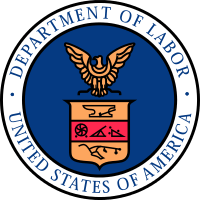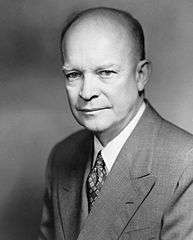James P. Mitchell
| James P. Mitchell | |
|---|---|
|
The official portrait of James P. Mitchell hangs in the Department of Labor | |
| 8th United States Secretary of Labor | |
|
In office October 9, 1953 – January 20, 1961 | |
| President | Dwight D. Eisenhower |
| Preceded by | Martin P. Durkin |
| Succeeded by | Arthur J. Goldberg |
| Personal details | |
| Born |
November 12, 1900 Elizabeth, New Jersey, United States |
| Died |
October 19, 1964 (aged 63) Manhattan, New York, United States |
| Resting place | St. Gertrude's Cemetery, Colonia, New Jersey, United States |
| Nationality | American |
| Political party | Republican |
| Spouse(s) | Isabelle Nulton Mitchell |
| Children | Elizabeth Mitchell |
| Parents |
Peter John Mitchell Anna C. Dirscoll |
| Residence | Colonia, New Jersey, United States |
| Alma mater | St. Patrick High School (New Jersey) |
| Profession | Politician and businessman |
| Religion | Roman Catholic |
James Paul Mitchell (November 12, 1900 – October 19, 1964) was an American politician and businessman from New Jersey. Nicknamed "the social conscience of the Republican Party," he served as United States Secretary of Labor from 1953 to 1961 during the Eisenhower Administration. Mitchell was a potential running mate for the 1960 Republican presidential candidate, Vice President Richard M. Nixon. However, Nixon chose Henry Cabot Lodge Jr. After an unsuccessful run for Governor of New Jersey in 1961, he retired from politics.
Early career
Mitchell was born on November 12, 1900, and was raised in Elizabeth, New Jersey. His father, Peter John, died in 1912. His mother was Anna C. Driscoll. Mitchell attended Battin High School and graduated from St. Patrick High School in 1917. His uncle was the character actor Thomas Mitchell. Mitchell married Isabelle Nulton on January 22, 1923. He began his political career in 1932 as the Union County supervisor for the New Jersey Relief Administration. Six years later he was appointed to the New York City division of the Works Progress Administration.
When Brehon B. Somerwell went to Washington, D.C. to lead the Army Construction Program, he made Mitchell head of the labor relations division of the Army Construction Program. In 1942 Mitchell became director of industrial personnel for the War Department, in charge of one million men. After World War II he returned to the private sector; in 1947 he was director for labor relations and operations at Bloomingdale Brothers. In 1948 he was hired by the Army for personnel work in Germany, and was later responsible for a similar task in Korea. He also sat on the personnel advisory board of the first Hoover Commission.
President Eisenhower's Administration
In 1953 Mitchell was appointed Assistant Secretary of the Army in charge of manpower and reserve forces affairs. Several months later he was nominated by President Eisenhower to replace Secretary Martin P. Durkin, who had resigned in protest in September 1953.[1]
On October 9, 1953, Mitchell became the Eighth Secretary of Labor and served in that capacity for the remainder of the Eisenhower Administration. He was an advocate of labor--he fought against employment discrimination, opposed right-to-work laws, and was concerned about the plight of migrant workers. During a top secret selection process in March, 1958, President Eisenhower appointed Secretary Mitchell administrator-designate of the "Emergency Manpower Agency," making him one of the Eisenhower Ten.
Achievements as Secretary
Mitchell encouraged management cooperation, supported labor's right to organize, and sought to improve conditions for marginal workers. He established the administrative machinery of the Landrum-Griffin Act and improved DOL organization and morale while reducing overlapping functions. J. Ernest Wilkins Sr. was appointed Assistant Secretary of Labor for International Affairs in 1954, the first African-American to be appointed to the level of Assistant Secretary in American government. Representing Mitchell and the DOL, Wilkins attended Cabinet meetings--also a first for an African-American.
The Welfare and Pensions Plans Disclosures Act was established on August 28, 1958, followed by the Labor-Management Reporting and Disclosure Act on September 14, 1959. Mitchell supported minimum wages for the soft-coal industry and other industries according to the Walsh-Healy Act.[2]
He is a member of the Labor Hall of Fame.
Governor's Race
After a bitter primary, Mitchell was elected Republican candidate for Governor of New Jersey with 43.7% of the vote, defeating State Senators Walter H. Jones and Wayne Dumont, Jr.. He lost the general election to Democratic candidate Richard J. Hughes, receiving 1,049,274 votes versus 1,084,194 votes for Hughes.
Mitchell retired from politics and rapidly advanced in the private sector. In 1961 he joined the Crown Zellerbach Corporation as a director and adviser. A year later he also briefly served as Vice President for Industrial and Public Relations, then as Senior Vice President for Corporate Relations until his death.
On October 19, 1964, Mitchell died of a myocardial infarction ("massive heart attack") in his suite at the Hotel Astor in Manhattan, New York. He is interred in St. Gertrude's Cemetery in Colonia, New Jersey.
References
- ↑ Guzda, Henry P. "James P. Mitchell: social conscience of the Cabinet", Monthly Labor Review, August 1991. Retrieved June 20, 2008.
- ↑ "U.S. Department of Labor - Labor Hall of Fame - James P. Mitchell". Dol.gov. Retrieved 2010-05-14.
External links
- U.S. Department of Labor Biography
- Papers of James P. Mitchell, Dwight D. Eisenhower Presidential Library
| Political offices | ||
|---|---|---|
| Preceded by Martin P. Durkin |
U.S. Secretary of Labor Served under: Dwight D. Eisenhower October 9, 1953 - January 20, 1961 |
Succeeded by Arthur J. Goldberg |
| Party political offices | ||
| Preceded by Malcolm Forbes |
Republican Nominee for Governor of New Jersey 1961 |
Succeeded by Wayne Dumont |


